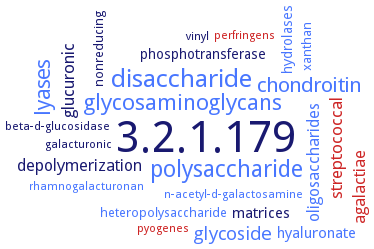3.2.1.179: gellan tetrasaccharide unsaturated glucuronosyl hydrolase
This is an abbreviated version!
For detailed information about gellan tetrasaccharide unsaturated glucuronosyl hydrolase, go to the full flat file.

Word Map on EC 3.2.1.179 
-
3.2.1.179
-
disaccharide
-
polysaccharide
-
glycosaminoglycans
-
lyases
-
chondroitin
-
glycoside
-
streptococcal
-
glucuronic
-
depolymerization
-
agalactiae
-
oligosaccharides
-
matrices
-
hyaluronate
-
hydrolases
-
phosphotransferase
-
xanthan
-
nonreducing
-
heteropolysaccharide
-
perfringens
-
rhamnogalacturonan
-
galacturonic
-
n-acetyl-d-galactosamine
-
pyogenes
-
vinyl
-
beta-d-glucosidase
- 3.2.1.179
- disaccharide
- polysaccharide
- glycosaminoglycans
- lyases
- chondroitin
- glycoside
- streptococcal
-
glucuronic
-
depolymerization
- agalactiae
- oligosaccharides
-
matrices
- hyaluronate
- hydrolases
-
phosphotransferase
- xanthan
-
nonreducing
- heteropolysaccharide
- perfringens
- rhamnogalacturonan
-
galacturonic
- n-acetyl-d-galactosamine
- pyogenes
-
vinyl
- beta-d-glucosidase
Reaction
Synonyms
CaUGL, CA_C0359, More, SagUGL, UGL, unsaturated glucuronyl hydrolase
ECTree
Advanced search results
General Information
General Information on EC 3.2.1.179 - gellan tetrasaccharide unsaturated glucuronosyl hydrolase
Please wait a moment until all data is loaded. This message will disappear when all data is loaded.
evolution
Clostridium acetobutylicum ATCC 824 gene CA_C0359 encodes a putative unsaturated rhamnogalacturonyl hydrolase (URH) with distant amino-acid sequence homology to YteR of Bacillus subtilis strain 168. YteR, like other URHs, has core structural homology to unsaturated glucuronyl hydrolases, but hydrolyzes the unsaturated disaccharide derivative of rhamnogalacturonan I. There is a conserved aspartic acid residue in both structures, which has been shown to be important for hydration of the C=C bond during the release of unsaturated galacturonic acid by YteR. A surface electrostatic potential comparison of CA_C0359 and proteins from CAZy families GH88 and GH105 reveals the make-up of the active site to be a combination of the unsaturated rhamnogalacturonyl hydrolase (EC 3.2.1.172) and the unsaturated glucuronyl hydrolase (EC 3.2.1.179) from Bacillus subtilis strain 168. Structural and electrostatic comparisons suggest that the enzyme may have a slightly different substrate specificity from that of YteR
malfunction
SagUGL mutants D115N and D115N/K370S show negligible enzyme activity. The side chain of Asn115 is drastically shifted in both mutants owing to the interaction with several residues, including Asp175, by formation of hydrogen bonds. This interaction between Asn115 and Asp175 probably prevents the mutants from triggering the enzyme reaction using Asp175 as an acid catalyst
additional information
additional information
substrate-bound enzyme structure modeling, overview
additional information
two Asp residues, Asp115 and Asp175 of Streptococcus agalactiae UGL (SagUGL), are completely conserved in other bacterial UGLs, one of which (Asp175 of SagUGL) acts as a general acid and base catalyst. The other Asp (Asp115 of SagUGL) also affects the enzyme activity
additional information
-
two Asp residues, Asp115 and Asp175 of Streptococcus agalactiae UGL (SagUGL), are completely conserved in other bacterial UGLs, one of which (Asp175 of SagUGL) acts as a general acid and base catalyst. The other Asp (Asp115 of SagUGL) also affects the enzyme activity


 results (
results ( results (
results ( top
top






